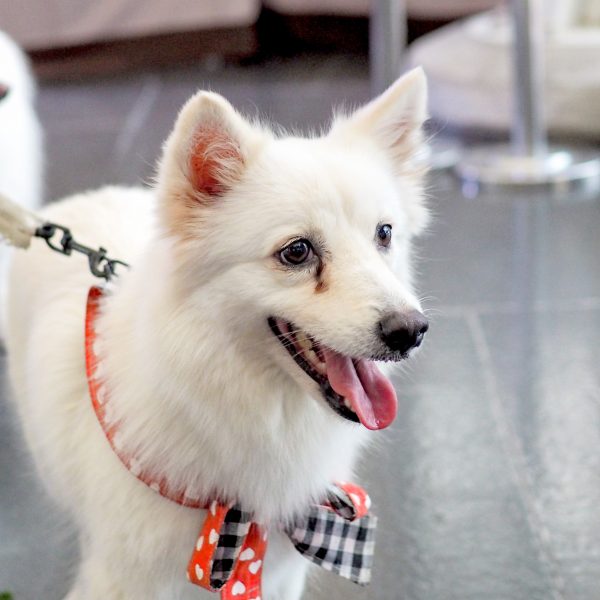Discoloration Around a Dog’s Eyes and Mouth: What it Means and What to Do
 Discoloration is most noticeable on dogs with light-colored fur. It also tends to be common in older dogs as well. The most common areas discoloration occurs is near a dog’s eyes and around its mouth. This is due to the porphyrins within tears and saliva, which causes the fur to gradually turn brown over time. The porphyrins are naturally occurring and are not a cause for concern. A small amount of discoloration around a dog’s eyes and mouth is normal.
Discoloration is most noticeable on dogs with light-colored fur. It also tends to be common in older dogs as well. The most common areas discoloration occurs is near a dog’s eyes and around its mouth. This is due to the porphyrins within tears and saliva, which causes the fur to gradually turn brown over time. The porphyrins are naturally occurring and are not a cause for concern. A small amount of discoloration around a dog’s eyes and mouth is normal.
However, it’s still a good idea to bring it up to your vet, especially if the staining seems abnormal or excessive. They’ll be able to tell you whether it’s within normal range or an early warning sign of something more serious. If you notice staining on other areas of the body, take note of that as well. If your dog is constantly licking the same spot, that could explain the discoloration and could also indicate a potential health issue in that area.
There are a variety of health issues that are associated with discoloration, or porphyrin staining, in certain areas. Some of them are annoying but normal, like seasonal allergies, while others are more serious, like periodontal disease or cancer. Here are a few reasons that could be causing discoloration around the eyes, mouth, and other areas of the coat:
Discoloration Around the Eyes
Anything that increases tear production can increase “tear stains” around your dog’s eyes. Dogs do not cry as we do; there are some reasons why dogs cry and are usually caused by something preventing their tear ducts from absorbing moisture properly.
Excessive or abnormal tears stains or staining near the eyes can indicate inflammation, such as allergies, an infection caused by bacteria, viruses, fungi, parasites, etc., or another eye problem in dogs. Any damage or trauma to the eye caused by the dog rubbing their paw against it, running through trees or tall grass, or any other situation in which the eye becomes irritated by an object can cause it to produce more tears; thus, more discoloration appears over time.
You do want to watch out for abnormalities and anything that can’t be explained by causes listed above. If you notice your dog’s eye doesn’t seem to be “sitting right” in the socket or is enlarged, bring it up to the vet as soon as you can.
There may be other explanations, but these are also signs of certain cancers that affect the eye. It’s also possible that there are other conditions causing the irritation, like ectopic cilia or entropion, which refer respectively to abnormally placed eyelashes or the rolling in of the eyelids.
Discoloration Around the Mouth
Since discoloration around the mouth is caused by saliva, common causes include anything that would produce extra saliva or result in more saliva hitting the “beard”, or the fur around your dog’s mouth.
Gum disease, tooth decay, or other dental problems are common causes of extra discoloration. Dogs who have dental issues also have a higher level of bacteria in their mouths, so more saliva is produced. Some dental issues can also cause drooling, which contributes to even more discoloration.
Dental problems can also cause difficulty in chewing food. Saliva is then unevenly distributed in the mouth, often causing it to trickle down the sides of the mouth or dribble. If your dog cannot properly close their mouth or has abnormalities that affect the mouth, saliva will exit at higher rates and accumulate on the fur nearby causing more staining.
If you see any of these issues in your dog, it’s important to make sure your vet is aware. They can help you with the dental issues and ensure nothing else is going on.

Discoloration on the Skin/Coat
Seeing discoloration in other areas of your dog’s coat can indicate some sort of inflammation or infection. If your dog has allergies, they may lick their paws or other areas, causing staining from the saliva. Inflammation can also be caused by food-related allergies.
Irritations to the skin caused by any embedded items, like splinters, can cause inflammation leading to discoloration from licking. Painful joints, flea bites, and more can also cause your dog to lick or chew on other areas of their coat, which can cause discoloration.
Infections caused by bacteria, fungi, or parasites can also cause your dog to lick or chew to gain relief from painful or itchy areas.
Regardless of what you see and where you see it, you’ll want to talk to your vet. They’ll be able to take your dog’s whole-body health into consideration and tell you if it’s something normal with a simple explanation, like allergies, or something more serious. Either way, your dog will get the help he needs and you’ll get peace of mind.
